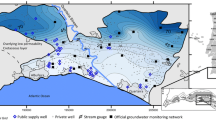Abstract
Six transient numerical groundwater flow models have been developed and calibrated based on six equally plausible conceptual models of the hydrogeological framework of Akyem and surrounding areas in southern Ghana, for the purpose of assessing the impacts of multiple stresses on groundwater resources sustainability in the area. The six conceptual models were developed to account for possible uncertainties in model predictions arising from uncertainties in the model structure and differ in terms of the characterization of domain boundaries and vertical stratification. The domain was conceptualized based on available data monitored over a 48-month period, from 41 boreholes in the area. Data from the 6 models were used to assess groundwater budget trends over the transient period to provide an indication of the state and sustainability of the resource under prevailing conditions in the area. All 6 models agree in terms of the trend in the variations of the key budget components and suggest that the resource is under threat due to the combined impacts of climate change and anthropogenic activities in the area. In decision-making processes regarding groundwater resources fortunes in a complex terrain it is strongly recommended that multiple numerical models, derived from multiple conceptual models, are developed to account for uncertainties associated with the definition and characterization of boundary conditions. This enhances confidence in the results of the modeling enterprise and facilitates.







Similar content being viewed by others
References
AMEC Geomatrix (2010) Hydrogeological Conceptual Model, Akyem Project Eastern Region, Ghana
Anderson MP, Woessner WW, Hunt RJ (2015) Applied Groundwater modeling: Simulation of flow and solute transport, 2nd edn. Elsevier
Aquaveo (2016) GMS 10.1 Tutorial MODFLOW—model calibration. Aquaveo, Provo, Utah
Bahmani R, Quarda TBMJ (2021) Groundwater level modeling with hybrid artificial intelligence techniques. J Hydrol 595:125659
Banoeng-Yakubo B, Yidana SM, Ajayi JO, Loh Y, Asiedu DK (2011) Hydrogeology and groundwater resources of Ghana: a review of the hydrogeological zonation of Ghana. McMann (ed), Potable Water and Sanitation. Nova Science Publishers
Clear Creek Consultants Inc (2010) Newmont Golden Ridge Limited Proposed Akyem Gold Mine Project- Ghana, Africa Meteorological Monitoring Program Data Summary and Review: Year 2009
Dapaah-Siakwan S, Gyau-Boakye P (2000) Hydrogeologic framework and borehole yields in Ghana. Hydrogeol J 8:405–416
Fetter CW (2001) Applied Hydrogeology, 4th edn. Prentice Hall
Ghana Statistical Service, GSS (2012) 2010 Population and Housing Census. Ghana Statistical Service, Accra
Golder (2006) Akyem Pumping Tests. Technical Memorandum, January 2006
Golder (2017) Regional Groundwater Model for Akyem Mine. Golder Associates, Accra
Golder and Associates, Golder (2004) Hydrogeologic Conditions at Akyem. Technical Memorandum to NGGL. October 2004
Griffis RJ, Barning K, Agezo FL, Akosah FK (2002) Gold deposits of Ghana. Minerals Commission Report
Harbaugh AW, Banta ER, Hill MC, McDonald MG (2000) MODFLOW-2000, The U.S. Geological Survey modular ground-water model—User guide to modularization concepts and the ground-water flow process: U.S. Geological Survey Open-File Report 00–92, 121p
Healy RW, Cook PG (2002) Using Groundwater levels to Estimate Recharge. Hydrogeol J 10:91–109
Hirdes W, Davis DW (2002) U-Pb geochronology of Paleoproterozoic rocks in the southern part of the Kedougou-Kéniéba Inlier, Senegal, West Africa: evidence for diachronous accretionary development of the Eburnean Province. Precambrian Res 118:83–99
Kesse GO (1985) The Mineral and Rock resources of Ghana. Geological Survey Department A.A. Balkema, Rotterdam
Mengistu HA, Demlie MB, Abiye TA, Xu Y, Kanyerere T (2019) Conceptual hydrogeological and numerical groundwater flow modelling around the Moab Khutsong deep gold mine, South Africa. Groundw Sustainable Dev 9:100266
Mustafa SMT, Hasan MM, Saha AK, Rannu RP, Uytven EV, Willems P, Huysmans M (2019) Multi-model approach to quantify groundwater-level prediction uncertainty using an ensemble of global climate models and multiple abstraction scenarios. Hydrology and Earth Systems Sciences 23:2279–2303
Perera E, Zhu F, Dodd N, Briganti R, Blenkinsopp C, Turner IL (2019) Surface- groundwater flow numerical model for barrier beach with exfiltration incorporated bottom boundary layer model. Coast Eng 146:47–64
Refsgaard JC, Van der Sluijs JP, Brown J, Van der Keur P (2006) A framework for dealing with uncertainty due to model structure error. Adv Water Resour 29:1586–1597
Sharafati A, Asadollah SBHS, Neshat A (2020) A new artificial intelligence strategy for predicting the groundwater level over the Rafsanjan aquifer in Iran. J Hydrol 591:125464
Water R, Commission WRC (2011) Final Technical Report: Hydrogeological Assessment of the Northern Regions of Ghana Project (HAP). Water Resources Commission
Yu X, Moraetis D, Nikolaides NP, Li B, Duffy C, Liu B (2019) A coupled surface- subsurface hydrologic model to assess groundwater Flood risk spatially and temporally. Environ Model Softw 114:129–139
Acknowledgements
The authors did not receive any form of financial support for this research. However, we acknowledge Newmont Ghana Gold Limited for the groundwater monitoring data.
Funding
The authors did not receive any form of funding for this research. We, however acknowledge Newmont Ghana Gold Limited for some of the hydrogeological data used for this research.
Author information
Authors and Affiliations
Contributions
The idea and concept for this paper were developed by SMY. He proceeded to lead in the data acquisition, conceptualization, numerical model development, calibration and scenario analysis as well as the drafting of the manuscript. EAD contributed the drafting of the literature review on the geology of the area and the formulation of the scenarios. RAM contributed to the conceptual model development and the processing of the hydrogeological data for the numerical modeling. JDT developed all the maps and contributed to the drafting and review of the manuscript.
Corresponding author
Ethics declarations
Ethical Approval
This research did not involve human or animal subjects and therefore did not require ethical approvals. The research was however carried out with the highest level of ethical standards.
Consent to Participate
The research did not involve human subjects. Therefore, there were no requirements of consent to participate.
Consent to Publish
The authors grant full rights to publish and freely distribute the content of this paper once it is accepted for publication in the Water Resources Management Journal.
Competing Interests
The authors have no competing interests to declare in relation to the content of this manuscript.
Additional information
Publisher’s Note
Springer Nature remains neutral with regard to jurisdictional claims in published maps and institutional affiliations.
Rights and permissions
Springer Nature or its licensor (e.g. a society or other partner) holds exclusive rights to this article under a publishing agreement with the author(s) or other rightsholder(s); author self-archiving of the accepted manuscript version of this article is solely governed by the terms of such publishing agreement and applicable law.
About this article
Cite this article
Yidana, S.M., Dzikunoo, E.A., Tetteh, J.D. et al. Multiple Conceptual Model Approach for Assessing Groundwater Resources Sustainability Under Multiple Stresses. Water Resour Manage 38, 173–191 (2024). https://doi.org/10.1007/s11269-023-03662-2
Received:
Accepted:
Published:
Issue Date:
DOI: https://doi.org/10.1007/s11269-023-03662-2




